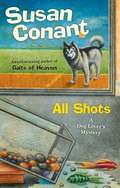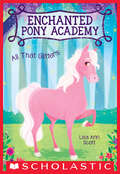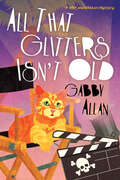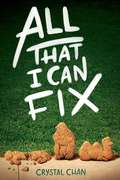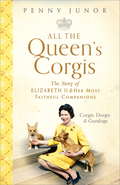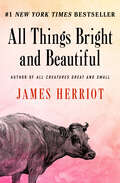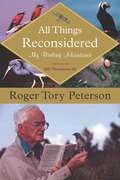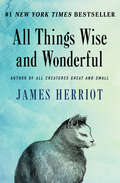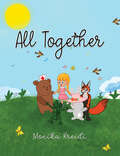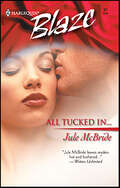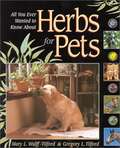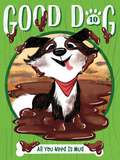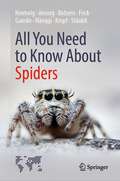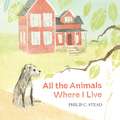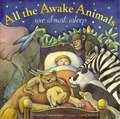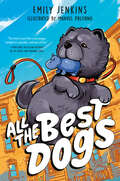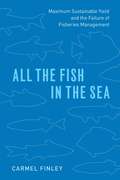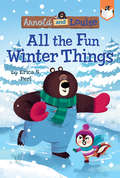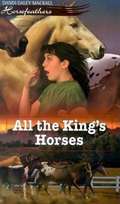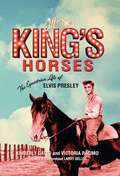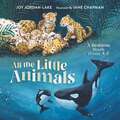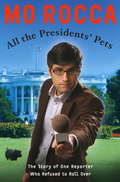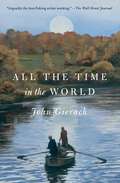- Table View
- List View
All Pets Go To Heaven: The Spiritual Lives of the Animals We Love (Playaway Adult Nonfiction Ser.)
by Sylvia BrownePets have a special place in our hearts and homes -- but do they share our destiny after death? World famous psychic, spiritual teacher, and New York Times bestselling author Sylvia Browne exercises her astonishing insight to illustrate the very special purpose our pets have on Earth -- and what animals experience after death. Cats, dogs, horses, and other creatures not only inhabit our homes but also our hearts. With their never-ending loyalty, heroic deeds, comic behavior, and vibrant personalities, pets are companions but can also be our closest friends and dearest confidants. The death of a pet is always heart wrenching and tragic. Legendary psychic Sylvia Browne provides comfort for those grieving over the loss of a beloved animal by showing how pets continue to be with us even after their deaths. Sylvia uses forty years of research and decades' worth of true stories culled from readings and her own experiences to show how our pets have unique personalities, quirks, and habits that make up their spirit and soul. Sharing heartwarming stories from pets on both sides of life, Sylvia Browne examines how our animals live in the afterlife, whether we will see them on the Other Side, how their presence affects us daily, and where animals fit into the whole of Creation. In All Pets Go to Heaven, Sylvia Browne explains how pets, like humans, have a spirit that travels to the Other Side.
All Shots: A Dog Lover's Mystery
by Susan ConantHolly Winter the Malamute trainer knows she's not the only Holly Winter living in Cambridge, Massachusetts, but it would be so much nicer if Holly number two weren't a dog-hating academic. . . and if a third woman calling herself Holly Winter didn't happen to be dead. Holly number one can attest to this unfortunate fact, having discovered the gunned-down body while searching for a missing Siberian husky. Another missing dog--this time a blue Malamute-- is somehow tied into this tangled web. With her husband Steve away on a camping trip and her other human housemates otherwise occupied, Holly and her prize-winning pups will have to bring the case to heel on their own--before a killer sniffs them out.
All That Glitters (Enchanted Pony Academy #1)
by Lisa Ann ScottIn this fabulous fantasy series opener, one of the newest students at a school for magical ponies learns about confidence and the power within.Daisy is thrilled to be attending the Enchanted Pony Academy, where glitter ponies learn to use their magic. But she’s nervous, too. Daisy’s hooves are sparkly, just like every other magical pony’s, but they don’t give off glitter. And worse, she has no idea what her magical power might be!Will the Academy help Daisy discover her magic and make all her dreams come true . . . or will she learn that there’s been a huge mistake?
All That Glitters Isn't Old (A Whit and Whiskers Mystery)
by Gabby AllanThe latest in the delightful cozy mystery series set off the coast of California—perfect for fans of Jasmine Guillory and Abby Collette. When she&’s not piloting a glass bottom boat, showing the sights to tourists, Whit sells seashells by the seashore—among many other sea and sand souvenirs—to help keep her family shop, Nautically Yours, afloat. It&’s a far cry from her corporate climbing ladder life in Los Angeles, but Whit and her frisky feline, Whiskers, love calling Catalina home and being close to family. Especially Whit&’s grandmother Goldy, a fun and feisty senior who always marched to the beat of a different drum. In her youth, Goldy was an item with a Catalina catch named Darren. But it was actually a ruse to fool Darren&’s parents who wouldn&’t have accepted his preference for men. Eventually, he left the island and chose the life—and life-partner—he wanted for himself. Back in town for his mother&’s funeral, Darren takes the opportunity to heal his open wounds, and settle some scores. In a surprise to the residents, Darren produced a documentary about the history of Catalina, and has arranged a premiere screening in the local theater. But his film career is cut short when his partner&’s dead body is discovered the night before the opening. Rumor swirl about Darren's past, along with is partner's—and the things they&’ve done—giving a lot of folks a lot of motives. Now, it's up to Whit and her boyfriend policeman to catch a killer, and uncover just how much Grandma Goldy knows about the back door deals tied to Darren&’s past… Praise for Much Ado About Nauticaling&“Colorful characters determined to weigh into Whit&’s private life promise much fun ahead. Cozy fans will be charmed.&” —Publishers Weekly
All That I Can Fix
by Crystal ChanA teen boy’s world gets turned upside-down when a zoo of exotic animals takes over his small town in this wickedly funny, heartbreakingly honest novel that’s perfect for fans of Shaun David Hutchinson. <P><P>In Makersville, Indiana, people know all about Ronney—he’s from that mixed-race family with the dad who tried to kill himself, the pill-popping mom, and the genius kid sister. If having a family like that wasn’t bad enough, the local eccentric at the edge of town decided one night to open up all the cages of his exotic zoo—lions, cheetahs, tigers—and then shoot himself dead. Go figure. Even more proof that you can’t trust adults to do the right thing. Overnight, news crews, gun control supporters, and gun rights advocates descend on Makersville, bringing around-the-clock news coverage, rallies, and anti-rallies with them. With his parents checked out, Ronney is left tending to his sister’s mounting fears of roaming lions, stopping his best friend from going on a suburban safari, and shaking loose a lonely boy who follows Ronney wherever he goes. Can Ronney figure out a way to hold it together as all his worlds fall apart? <P><P>From acclaimed author Crystal Chan comes an incisive tale of love, loyalty, and the great leaps we take to protect the people and places we love most.
All The Queen's Corgis: Corgis, dorgis and gundogs: The story of Elizabeth II and her most faithful companions
by Penny Junor'It is actually a serious book, but it had me laughing out loud several times on the Tube. All mothers should receive one for Christmas.' Marcus Berkmann, SpectatorEveryone who loves The Crown on Netflix will enjoy this celebration of Queen Elizabeth II and her beloved canine friends.The Queen has had corgis by her side ever since she was seven years old and persuaded her father to buy one for the family. She also has several dorgis (a cross resulting from an accidental liaison between one of the Queen's corgis and Princess Margaret's dachshund) and is a passionate breeder of gundogs.The dogs are the Queen's constant companions, travelling with her by air, road and rail, from one royal residence to another. She walks and feeds them herself, chooses names for them, and at the end of their days, buries them with personalised plaques to commemorate each individual. Penny Junor reveals the scraps and scrapes that the dogs have been involved in - the hierarchy amongst them, the corgis' feisty attitude to footmen and guests, gardeners and innocent passersby. This fascinating and affectionate look at the Queen and her most faithful companions is a book for dog lovers everywhere about what really makes our much-loved and longest reigning monarch truly light up.
All Things Bright and Beautiful: The Warm And Joyful Memoirs Of The World's Most Beloved Animal Doctor (All Creatures Great and Small #2)
by James HerriotFrom the #1 New York Times–bestselling author of All Creatures Great and Small: more true stories of a veterinarian in small-town Yorkshire, England. After his first day on the job, James Herriot&’s mentor warns him that the life of a country veterinarian is full of small triumphs and big disasters, but that he&’d never be bored. From night visits to drafty barns during freezing northern England winters, to the beautiful vitality of rural life in the summertime, to the colorful menagerie of animals—and their owners—that pass through his office, Herriot experiences new challenges and joys every day. In these pages, Herriot trains under his eccentric boss Siegfried Farnon in a rustic English village, courts the woman that becomes his wife, and meets the people he would come to write about for a lifetime.
All Things Reconsidered: My Birding Adventures
by Roger Tory PetersonRoger Tory Peterson’s unique perspective on birding comes to life in these highly personal narratives. Here he relates his adventures during a lifetime of birding and traveling the world to observe and record nature. Though Peterson was widely known for his illustrations, this collection reminds us to reconsider his accomplishments as a photographer, for Peterson was nearly as passionate about photography as he was about painting. The essays and photographs included here were carefully selected by Bill Thompson III, the editor of Bird Watcher’s Digest, which ran the column “All Things Reconsidered” during the last twelve years of Peterson’s life.
All Things Wise and Wonderful: The Warm And Joyful Memoirs Of The World's Most Beloved Animal Doctor (All Creatures Great and Small #3)
by James HerriotWorld War II intrudes on the pastoral life of the Yorkshire veterinarian and #1 New York Times–bestselling author of All Creatures Great and Small. Only a couple of years after settling into his new home in northern England, James Herriot is called to war. In this series of poignant and humorous episodes, the great veterinarian shares his experiences training with the Royal Air Force, pining for a pregnant wife, and checking in on the people back home who made his practice so fascinating. As the young men of Yorkshire are sent into battle and farmers consider the broader world they&’re a part of, Herriot reflects on the lives—human and animal alike—that make his home worth fighting for.
All Together
by Monika KreidiAll Together is a beautifully rhymed story of a little girl, Petra, and the forest animals that help her chase after a speaking, singing frog. This fun adventure takes the little girl through a magical forest, where she meets a rabbit, a fox, and a bear in a chase after the frog. This melodic book teaches a valuable lesson about friendship and helping each other in need, no matter our differences. It spreads pure joy to the little ones through delightful illustrations and melodic words.
All Tucked In . . .
by Jule McBrideCoffee shop owner Carla DiDolche is tossing and turning, but it isn't the java keeping her up at nights. A short stay at the sleep clinic belonging to ex-love Tobias Free could be the answer. Until Carla starts having erotic dreams about sizzling sex with Tobias...images that seem so real!Tobias would love to cure Carla's insomnia with dream therapy. But it's pure torture tucking her in...watching over her at night. Every moan, every quiver has him fantasizing about their heated past. He's so tempted to slip between the sheets. But can he put their tangled history aside and turn her nightmares into tantalizing dreams?
All You Ever Wanted to Know About Herbs for Pets
by Mary L. Wulff-Tilford Gregory L. TilfordHerbs for Pets is an indispensable resource for pet owners. Written by two of the world's most respected herbalists, this comprehensive guide contains a broad range of cutting-edge scientific information as well as traditional, historical, and philosophical perspectives on hundreds of medicinal plants and natural medicines. Turn the pages of this spectacularly illustrated book and learn all about holistic herbalism; natural nutrition; North American herbs, including Western; ayurvedic, and Chinese herbs that grow in North America; homeopathy; and how to treat diseases, ailments, and medical conditions herbally.
All You Need Is Mud (Good Dog #10)
by Cam HigginsIn this charming tenth book of the Good Dog series, Bo plays in the mud with his pig friend!Bo and his pig pal Zonks always have fun with each other. They can talk and roll in the mud all day long! Bo and Zonks agree they have a special connection. But does that mean they&’ve got to be each other&’s best friend? With easy-to-read language and illustrations on almost every page, the Good Dog chapter books are perfect for emerging readers.
All You Need to Know About Spiders
by Wolfgang Nentwig Jutta Ansorg Angelo Bolzern Holger Frick Anne-Sarah Ganske Ambros Hänggi Christian Kropf Anna StäubliAll You Need to Know About SpidersSpiders are super predators and devour everything they can overpower. To do this, they have developed incredibly good catching techniques and, with spider silk, a tool that makes material technology green with envy. The males are usually smaller than the females and, in order to have sex, they have to come up with a lot to avoid being misunderstood as easy prey: Dancing, drumming, and gifts almost always help. Spiders use their venom in very precise doses, and since humans are not on their menu, they are harmless to us. Many people's (unnecessary) fear of spiders finds cultural roots as early as the Middle Ages. Nevertheless, spider fear is easily treatable. There is no habitat or building without spiders. And that's a good thing, because spiders have fascinating properties and their world is full of surprises. Everything you need to know about them is explained in this book in understandable language by experts for laymen. In addition, some of the most common spider species in the house and garden are briefly presented with tips for observation. The authorsThis book is authored by eight scientists, all of them members of the Association for the Promotion of Spider Research: Wolfgang Nentwig, Jutta Ansorg, Angelo Bolzern, Holger Frick, Anne-Sarah Ganske, Ambros Hänggi, Christin Kropf und Anna Stäubli
All in the Furry Family: Cat Tales Book Two (Cat Tales)
by Eileen O'FinlanCan a cat be a bridezilla? In Fauanburg she can in this delightful sequel to All The Furs and Feathers. The success of Oneness Park has brought big changes to town. Smokey is now Abigail Fluffington’s partner at Fluffington ArCATechture. Autumn Amelia runs the wildly popular Mama Cat’s Kitchen. But it’s not all fun and games. Two strange cats are stalking Smokey. When she finally confronts them, she gets the shock of a lifetime. Meanwhile, Greyson and Abigail Fluffington's wedding is threatened as Abigail keeps changing her mind about the menu, the cake, the flowers, even the invitations. Her antics are driving all the furs and feathers crazy!
All the Animals Where I Live
by Philip C. SteadThe author used to live in the busy city where there were buses and trains, and people waiting for buses and trains.Now he lives in the country and jubilantly takes us on a tour of his home, pointing out all the animals that share his space. There are stuffed bears and quilted chickens. His dog Wednesday watches cranes, frogs, and dragonflies live their lives. Coyotes and chipmunks come and go, and the world around where he lives is full of life, until winter comes, and there is nothing but snow.Uniquely structured, All the Animals Where I Live is a picture book from Philip C. Stead, one of our most innovative author-illustrators, that is a meditation on life and moments big and small that shape our individual worlds.
All the Awake Animals are Almost Asleep
by Crescent DragonwagonAn alphabet of animals prepare to go to sleep.
All the Best Dogs
by Emily JenkinsFor anyone who loves a dog--and anyone who loves a laugh, comes this sensitive (and silly!) story about growing up and mending fences. An enduring message of friends, community, and the joy of pets.Ask anyone who has a dog and they&’ll tell you that their dog is the best. Really, truly, the best dog in the world. Theirs is the best dog that ever lived, ever, ever, in the history of the known universe.Welcome to the dog park! It&’s a playground for dogs in the big city. Here, four sixth graders (and their dogs!) overlap on one hilarious and important June weekend. Ezra needs to find his lost dog. Cup-Cup needs a friend. (She also needs to learn to walk on a leash.) Mei-Alice wonders if anyone will ever understand her. Panda wonders what will happen if she breaks the rules. Kaleb is covering up a terrible mistake. Grover and Lottie are making lots of terrible mistakes. (Some of them are disgusting.) And Jilly needs to make a new life in a new place. On this almost-summer weekend, a series of surprises, mishaps, and misunderstandings will end up changing all of their lives.
All the Fish in the Sea: Maximum Sustainable Yield and the Failure of Fisheries Management
by Carmel FinleyBetween 1949 and 1955, the State Department pushed for an international fisheries policy grounded in maximum sustainable yield (MSY). The concept is based on a confidence that scientists can predict, theoretically, the largest catch that can be taken from a species’ stock over an indefinite period. And while it was modified in 1996 with passage of the Sustained Fisheries Act, MSY is still at the heart of modern American fisheries management. As fish populations continue to crash, however, it is clear that MSY is itself not sustainable. Indeed, the concept has been widely criticized by scientists for ignoring several key factors in fisheries management and has led to the devastating collapse of many fisheries. Carmel Finley reveals that the fallibility of MSY lies at its very inception—as a tool of government rather than science. The foundational doctrine of MSY emerged at a time when the US government was using science to promote and transfer Western knowledge and technology, and to ensure that American ships and planes would have free passage through the world’s seas and skies. Finley charts the history of US fisheries science using MSY as her focus, and in particular its application to halibut, tuna, and salmon fisheries. Fish populations the world over are threatened, and All the Fish in the Sea helps to sound warnings of the effect of any management policies divested from science itself.
All the Fun Winter Things #4 (Arnold and Louise)
by Erica S. PerlThere's too much fun to be had in the snow to sleep through the winter season! At least that's what Louise thinks. In this story designed to engage early readers, charming characters combine with simple text, lively illustrations, and laugh-out-loud humor to help boost kids' confidence and create lifelong readers!Snow has fallen and the pond is frozen, so Arnold knows that--as a bear--it's time to hibernate! But Louise insists that he'll miss all the fun winter things if he does, so she convinces him to try hibernating like a chipmunk instead. They'll sleep for a short time, wake up to go sledding or have a snowball fight, and repeat! The only problem is, Arnold can't seem to keep his eyes open. What if he can't stay awake for the winter fun? Exciting, easy-to-read books are the stepping stone a young reader needs to bridge the gap between being a beginner and being fluent.
All the King's Horses (Horsefearthers #5)
by Dandi Daley MackallSarah "Scoop" Coop's life revolves around her horse, Orphan, and the stability of the family stable business. Scoop learns major coming-of-age lessons as she learns to rely on God.
All the King's Horses: The Equestrian Life of Elvis Presley
by Kimberly Gatto Victoria RacimoWhen Elvis Presley decided he wanted to buy a horse in 1966, he didn't want just any horse. "He wanted a Golden Palomino," Priscilla Presley remembers. "He would get up at 3:00 in the morning, go to certain farms and ranches and say, 'Do you have a Golden Palomino for sale?' People would say, 'That was Elvis Presley!" Elvis's legendary love of horses drove him to find the Golden Palomino who would become his beloved companion Rising Sun, and to fill Graceland's stables and Circle G Ranch with horses for family and friends to ride. In the first-ever book dedicated to Elvis's equestrian side, horse lovers Kimberly Gatto and Victoria Racimo share rare stories, interviews, and photographs that shed light on the beautiful, quiet life the King lived when he was with his horses.
All the Little Animals: A Bedtime Book from A-Z
by Joy Jordan-LakeFrom armadillos to zokors and everything in between, you and your littles are invited to follow along as the animals of the world go to bed. Learn about their silly routines and their super-sweet snuggles as you tuck in and kiss your own little baby bears good night.Author Joy Jordan-Lake has brought to life her great-grandmother's tradition of putting the children to bed with this gentle litany. And illustrations by bestselling illustrator Jane Chapman make this bedtime book come to life.All the Little Animals: A Bedtime Book from A-Z is perfect forboys and girls ages 4 to 8 years old and families looking for a sweet and lyrical bedtime read,children interested in exploring the different types of animals around the world,bringing the zoo to you on rainy days, andteaching littles the alphabet.Start a new family tradition with All the Little Animals.
All the Presidents' Pets: The Story of One Reporter Who Refused to Roll Over
by Mo RoccaAll the Presidents' Men meets Charlotte's Web in an explosive political exposé that blows the lid off a long-held secret in Washington: The Presidents' pets are more than just furry photo ops. How much does the public really know about the role of the President? Does the White House Press Corps really understand it? Does the President himself have a clue? All the Presidents' Pets is the long-awaited, spine-tingling, muckraking blockbuster from political and pop culture commentator Mo Rocca--a tour de force of investigative reporting that for the first time tells the true story of who really runs America. From George Washington's donkey, Royal Gift, and Rutherford B. Hayes's Siamese cat, Miss Pussy, to Lincoln's goats, Nanny and Nanko, and John Kennedy's Welsh terrier, Charlie, each has left an indelible mark on the White House. (In fact, Eisenhower's Weimaraner, Heidi, did leave a terrible stain on the Diplomatic Reception Room carpet. She was promptly exiled to Ike's Gettysburg farm.) InA ll the Presidents' Pets, Rocca lays bare the true stories of our nation's First Pets and sheds light on the origins and evolution of presidential power. Rocca plumbs rare sources, with the assistance of veteran White House correspondent Helen Thomas (the Stefanie Powers to his Robert Wagner), for the poop--er, scoop--on what really goes on in the West Wing. Once Helen reveals her deepest, darkest secret, the story turns dangerous. Filled with revelations and news breaks--and an unforgettable cast, including Wolf Blitzer, Ann Coulter, Sean Hannity, and a terrifying albino named Gephardt (no relation)--this is yet another story that the complacent Washington press corps missed. Forget Paul O'Neill. Richard Clarke? Who's that? All the Presidents' Pets is the groundbreaking political book that Bob Woodward could have written had he just spent a little less time with the President and a little more time with Barney. "Some will consider this satire. Mo Rocca describes how U.S. political policy has been guided by presidential pets for more than two hundred years. Oh, and I suppose you have a better explanation?" --P. J. O'Rourke. "All the Presidents' Pets is a deeply probing, thoroughly engaging account about how the media has uniformly overlooked the White House pet phenomenon to the detriment of our national memory. Thanks to Mo Rocca, no serious political commentator can properly analyze the Bush Administration without taking into consideration 'The Barney Factor.' And, for good measure, he has broken the story of Helen Thomas's lair, a cosmic revelation that will force historians to reinterpret presidencies dating as far back as James Garfield's tenure." --Douglas Brinkley, Professor of History and Director of the Eisenhower Center for American Studies, University of New Orleans. "A freaky, phantasmagoric trip through the secret history of presidential pets."--Robert Siegel, former editor in chief of The Onion.
All the Time in the World (John Gierach's Fly-fishing Library)
by John GierachDiscover the answer to life&’s most pressing problems through the joy of fly-fishing from master philosopher John Gierach, &“the dean of fly-fishing&” (Kirkus Reviews), who is &“arguably the best fishing writer working&” (The Wall Street Journal).Once again, John Gierach tells the world why the pastime of fly-fishing makes so much sense—except when it doesn&’t. In this &“shrewd, perceptive, and wryly funny&” (The Wall Street Journal) book, he recalls the joys of landing that trout he&’s been watching for the last hour—and then losing an even fatter one a little later. Joy and frustration mix in Gierach&’s latest appreciation of the fly-fishing life as he takes us from his home waters on the Front Range of the Rockies in Colorado to the fishing meccas all over North America. From fishing lodges in Alaska to memories of the local creek in the Midwest where he grew up, Gierach celebrates the indispensability of the natural world around us.

